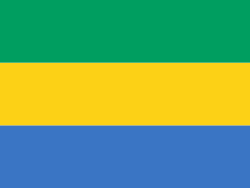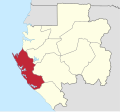 | |
| Use | Civil flag and ensign |
|---|---|
| Proportion | 3:4 |
| Adopted | 9 August 1960 |
| Design | A horizontal triband of green, gold and blue |
 Standard of the president of Gabon | |
| Proportion | 3:4 |
| Adopted | 2016 |

The flag of Gabon (French : drapeau du Gabon) is a tricolour consisting of three horizontal green, yellow, and blue bands. Adopted in 1960 to replace the previous colonial flag containing the French Tricolour at the canton, it has been the flag of the Gabonese Republic since the country gained independence that year. The design of the present flag entailed the removal of the Tricolour and the widening of the yellow stripe at the centre.


























